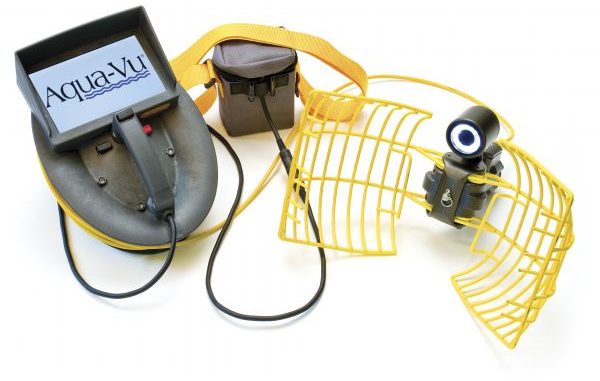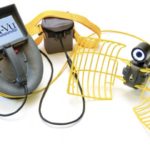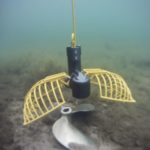
Aqua-Vu’s new system is like having your own scuba diver handy
Shortly after handheld GPS units became small enough to fit in a pocket, I remember a fellow outdoor writer lamenting about losing his. He somehow dropped it as he stepped from a boat to a dock over water 30 feet deep.
He was traveling and didn’t have time to find a diver to look for it. All of his prized fishing waypoints (public and secret) went to the bottom with that unit. Back in those early days, you couldn’t back-up your waypoint list on a computer; you had to copy them manually, and he hadn’t done that.
I lost a prop while pre-fishing for a bass club tournament on Lake Palestine in east Texas. One of the pulse packs on my 115 Johnson outboard died and my dealer replaced it. The mechanic put a load prop on the motor to test it in a tank and, after putting my prop back in place, apparently forgot to secure its mounting nut with a cotter pin.
I was in a hurry to get to the tournament and stupidly failed to double check that. On the first practice day I fired the engine up to move to another spot, put it in reverse to back away from a brush pile and the engine just revved while the boat sat still. I shut off the motor and tilted it up, all the while fearing the worst.
Yep, my nearly new, state-of-the-art, Teflon-coated stainless steel prop was gone.
Water visibility was about three feet through the water and unfortunately the water was eight feet deep. I poked around with a telescoping lure retriever for an hour and never touched the prop.
It seems that prescription eyeglasses and sun glasses, keys, wallets, rods and reels, landing nets, tools and countless other important and valuable items are just waiting for their chance to dive to the bottom. And, in the past, unless you knew a SCUBA diver, or were willing to hire one, chances are whatever sank stayed sunk.
I’m happy to say this is no longer true.
Aqua-Vu, a Minnesota-based company, began making underwater viewing systems back in 1997. Their remote underwater cameras can be found on the boats of serious fishermen to identify fish species and types of weeds, on the boats of law enforcement agencies to find victims and evidence, and even on docked cruisers where they fascinate kids of all ages with a real-time television view of what’s going on under the boat.
And now Aqua-Vu has introduced a model that makes retrieving what you see on the camera almost a snap.
The Aqua-Vu Claw Discover model combines HD color SONY optics, a 7-inch 800×480 pixel HD LCD with impact-resistant housing and protective tempered glass, a 13-LED camera lighting system, and an integrated robotic claw that can clamp down on and lift up to 50 pounds of weight.
The Claw is powered by a 24-volt battery pack good for eight hours of continuous use, and it includes a battery charger and a custom-molded carrying case.
The display unit connects to the camera and claw with 75 feet of heavy-duty marine cable with a breaking strength of more than 200 pounds. The motor-operated claw is made of steel and protected with an electroplated yellow finish.
Using the unit is simple. Put it over the side of your boat or lower it from a pier or dock. Move slowly while watching the HD television image until you see something that you want to pick up. A stabilizing fin keeps the camera and claw aimed in the direction that you move the cable. Align the claw with your target object and then hit the switch to close the claw. Finally, retrieve the object by pulling up the cable.
With 50 pounds of gripping power and 200 pounds of cable strength, you should be able to recover anchors and even objects as heavy as boat batteries.
This new search-and-recovery system can certainly be used solo, but I see combining it with one of the new Humminbird or Lowrance high-definition side-looking sonar units as an even better way to find lost objects.
For instance, if I lost a prop today, I’d install my spare aluminum prop, and then make a few passes over the area with the HD side-looking sonar, and I’d probably spot it quickly.
I’d set the sonar operating frequency at 800 kHz for best screen detail. Most units can also operate at 455 kHz, which generally gives you a longer reach but with slightly less screen detail — and detail would be my primary concern here.
I’d set the unit to look to one side only, and set its side-scanning range to 30 feet. This would spread the 30-foot side view over the entire screen, which would also improve the display detail.
I would make parallel, straight-line passes across the area, trying to overlap the sonar readings slightly so I didn’t miss anything. Scanning with a 30-foot swath would be much faster than covering the same area with just the camera.
When a likely shape appeared on the sonar display, I would move the screen cursor over it, zoom in on the object for a better look and save it as a waypoint if it looked promising.
When I was through scanning the area, I would go back to each marked waypoint and examine the spot with the Claw’s camera and grab the prop when I found it.
The Aqua-Vu Claw Discover retails for $999.99 direct from Aqua-Vu with free shipping.
The price carries a bit of sticker shock, but I can see where a waterfront property owner, a marina owner or a boater who regularly carries clumsy passengers could make it pay for itself and then some.
Visit www.aquavu.com/aqua-vu-claw-discover for more information.




